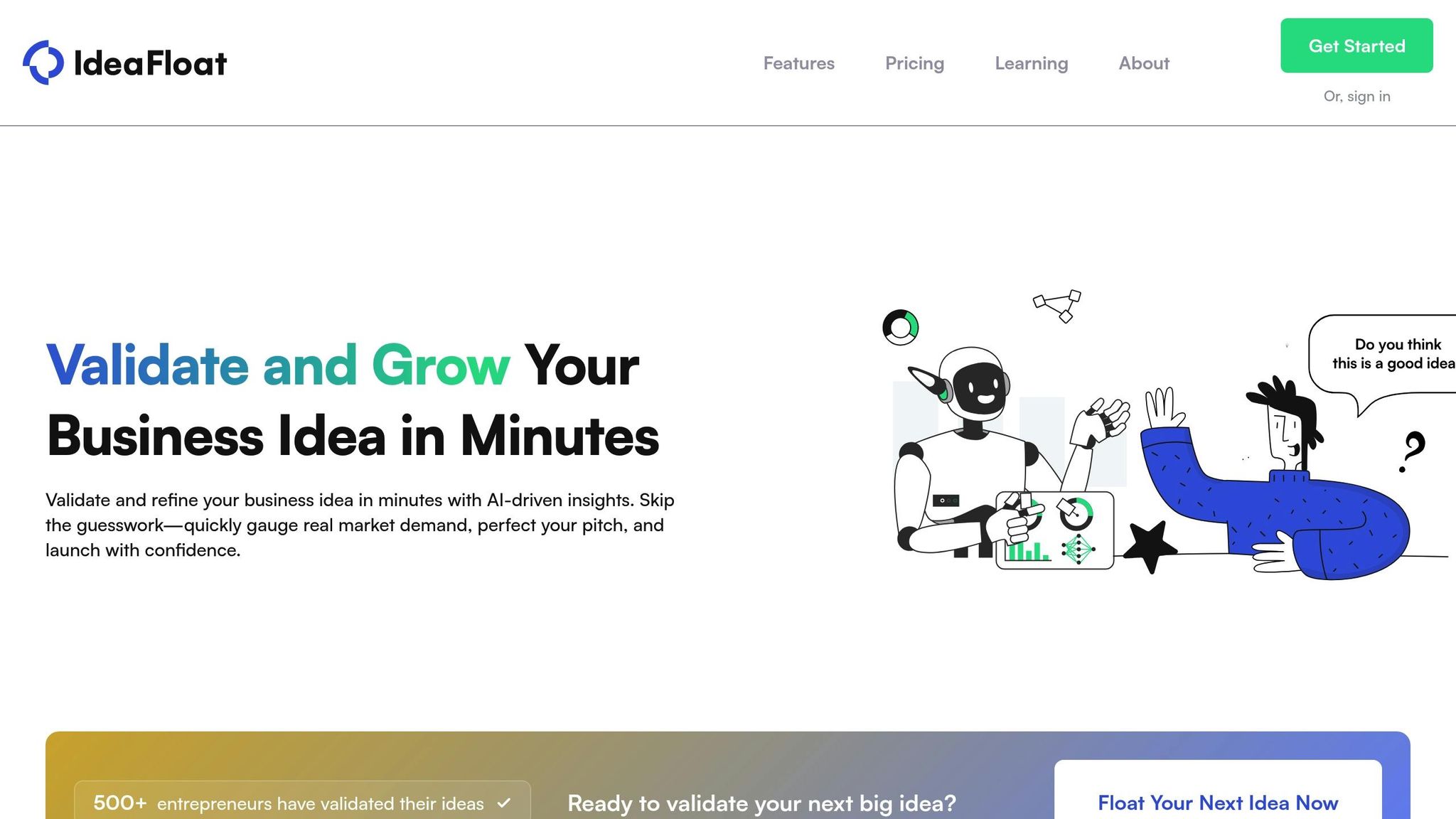
Turn your idea into a business in 3 days. IdeaFloat is an AI-powered platform that helps you validate, plan, and secure funding for your business idea in just 72 hours. Here's how it works:
- Validate Your Idea: Use tools like market analysis, customer insights, and SWOT analysis to assess your idea's potential.
- Plan Your Business: Create a business summary, financial plan, and pricing strategy with AI-driven tools.
- Secure Funding: Build investor-ready business plans and connect with potential investors through the platform.
- Launch Quickly: Follow a personalized launch checklist to kickstart your business.
With IdeaFloat, you can skip months of research and planning, and go from concept to funding in record time. Whether you're starting fresh or scaling up, this platform simplifies every step of the process.
How To Test ANY Startup Idea In 24 Hours (No Code + AI)
1. Getting Started with IdeaFloat

The journey from a simple idea to a fully-formed business starts with using IdeaFloat's tools. Each feature is designed to build on the previous one, helping create a strong business foundation.
Writing Your Business Summary
The Business Summary Generator from IdeaFloat helped me clearly define my business concept. By asking for specific inputs, it not only crafted a concise summary but also highlighted areas that needed more development.
Choosing a Business Name and Domain
Finding the right name was simple with the Business Name Generator. Plus, the built-in Domain Finder checked domain availability across various extensions, saving time and effort.
Measuring Market Size
The Market Size Assessment tool turned what could have been weeks of research into a quick and data-backed analysis. By entering details like the target audience, such as urban professionals aged 25-40, it provided an estimate of the market's potential value.
Defining Target Customers
IdeaFloat helped me pinpoint key customer details:
- Pain points and challenges
- Buying habits
- Decision-making criteria
- Potential market share
This clear customer profile allowed me to outline how my business would meet their needs.
Setting Your Value Proposition
With the Unique Value Proposition Generator, I created a clear and persuasive statement about my business benefits.
"IdeaFloat helps articulate the market potential and gives you the tools to provide clarity on your idea, ready to share it with investors, business partners, or friends."
2. Testing Your Business Idea
Once I outlined the core aspects of my business concept, I used IdeaFloat's tools to gather data and confirm its potential in the market.
Checking Your Validation Score
IdeaFloat's validation score offered an objective way to measure how viable my business idea was. By answering a detailed questionnaire, I got insights into key areas like customer acquisition, revenue model, and market differentiation. The results pointed out areas that needed work, such as improving how I planned to attract customers and sharpening my revenue strategy. After making adjustments, my score improved noticeably, giving me more confidence in the idea. With this clearer picture of strengths and weaknesses, I moved on to a SWOT analysis.
Running a SWOT Analysis
Using IdeaFloat's SWOT Analysis Generator, I quickly identified the internal and external factors affecting my business. Here’s what stood out:
- Strengths: A clear value proposition, low overhead costs, and a scalable business model
- Weaknesses: Limited starting capital, being new to the market, and a small team
- Opportunities: Increasing demand, untapped customer segments, and trends favoring digital solutions
- Threats: Economic shifts, changing regulations, and market unpredictability
This step helped me fine-tune my strategies and focus my resources where they mattered most.
Analyzing Competition
With the Competitor Analysis Generator, I got a clear view of my market positioning. It highlighted competitors' pricing, services, and overall market presence. The tool uncovered gaps in their offerings and pointed out underserved customer groups. This insight helped me craft a premium pricing strategy and identify ways to stand out. I then moved on to gathering feedback directly from potential customers.
Getting Customer Input
IdeaFloat's Real Customer Insights tool combed through online discussions to find common pain points and feature requests from potential users. This data helped me tweak my product and adjust my marketing approach.
"Assess your idea's potential, and our program will calculate the ideal score and highlight areas you need to work on." - IdeaFloat
These testing steps gave me the confidence to move forward and start building a strategy ready for funding.
sbb-itb-08dd11e
3. Planning Your Finances
Once I validated my business idea, I turned to IdeaFloat's financial tools to create a solid financial plan for my startup.
Calculating Initial Costs
Using IdeaFloat's Startup Cost Analyzer, I identified and categorized my initial expenses. The tool broke down costs into key areas like technology, equipment, marketing, legal fees, and day-to-day operations. This gave me a clear picture of how much capital I needed to get my business off the ground.
Setting Prices and Break-even Points
To define my pricing strategy, I relied on IdeaFloat's Pricing Analyzer. It evaluated market rates, production costs, and profit margins to suggest price points that balanced competitiveness and profitability. Paired with the Breakeven Analysis tool, I could estimate how long it would take to cover costs and start turning a profit.
Planning Funding Needs
IdeaFloat's Funding Calculator helped me figure out how much money I needed to sustain operations until the business became profitable. By inputting projected expenses, anticipated growth, and revenue estimates, I created a detailed funding plan. The Finance Structure Planning tool further allowed me to explore various financial scenarios, ensuring I was prepared to secure funding and keep the business stable.
These tools not only clarified my financial needs but also gave me the confidence to present a well-thought-out plan to potential investors. With my financial roadmap in place, I was ready to move forward with securing funding.
4. Getting Funded
After completing my financial plan with IdeaFloat, I was able to secure funding quickly. Here’s how IdeaFloat supported me every step of the way.
Building Your Business Plan
IdeaFloat's tools transformed my model into an investor-ready business plan. It combined market research, validation data, and financial projections into a professional format. The platform simplified creating both a lean canvas and a full business plan by including key elements like market analysis, financial forecasts, growth strategies, risk assessments, and an implementation timeline.
Finding Investors
IdeaFloat’s investor matchmaking tools helped me prepare materials that clearly showcased the market potential and profit outlook. Using its data-driven approach, I strengthened my pitch by focusing on validated opportunities and growth possibilities.
"IdeaFloat has been invaluable for expanding and franchising our business. It replaced months of research and Excel modeling with real-time data insights. Highly recommend!"
Once investor interest was confirmed, I refined my plan to ensure a strong launch.
Making a Launch Plan
With validation and investor outreach in place, I moved on to creating a detailed launch plan. IdeaFloat's Personalized Launch Checklist offered tailored action items based on my industry, resources, and timeline. This helped me prioritize tasks, set clear milestones, and coordinate with key stakeholders.
"IdeaFloat saved us weeks of work by helping us explore demand for new products across different regions and took the guesswork out of finding gaps in the market. A must-have for entrepreneurs looking to scale."
The Share Links feature allowed me to securely share business plans and analyses with potential investors. This added a layer of professionalism and efficiency to the entire funding process.
Conclusion: Start Your Business with IdeaFloat
With IdeaFloat, turning your concept into a fundable business can take as little as 72 hours. This AI-powered platform simplifies the business validation process, making it faster and more data-focused.
More than 500 entrepreneurs have already used IdeaFloat to validate their ideas successfully. Business Coach Lachlan Nicolson from Leader Guide highlights its effectiveness:
"IdeaFloat walks you through a step-by-step plan to discover, validate and launch your business."
By combining market analysis, financial planning, and investor matchmaking into one system, IdeaFloat replaces outdated, time-intensive methods with real-time, actionable insights. It takes the uncertainty out of business validation.
Whether you're working on your first idea or growing an existing business, IdeaFloat's tools help you move forward with confidence. Start with their free plan and join a community of entrepreneurs who have transformed their ideas into funded ventures.
Related posts
Get the newest tips and tricks of starting your business!


